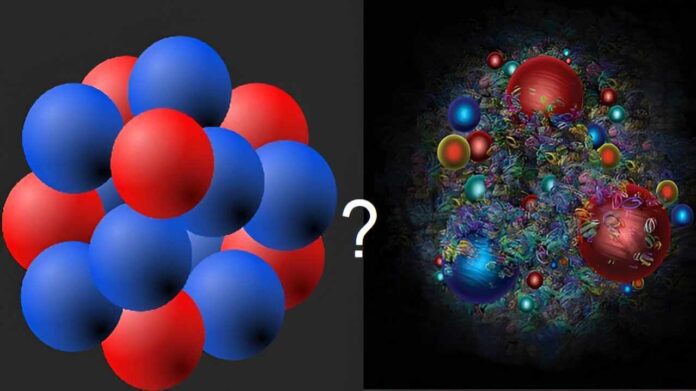Atomic nuclei are made of nucleons (like protons and neutrons), which themselves are made of quarks. When crushed at high densities, nuclei dissolve into a liquid of nucleons and, at even higher densities, the nucleons themselves dissolve into a quark liquid.
In a new study, published in the journal Physical Review B, researchers addressed the question of whether the liquids of nucleons and quarks are fundamentally different.
Their theoretical calculations suggest that these liquids are different. Both types of liquids produce vortices when they rotate, but in quark liquids, the vortices carry a “color-magnetic field,” similar to an ordinary magnetic field. There is no such effect in nucleon liquids. Thus, these vortices sharply distinguish quark liquids from nuclear liquids.
Quarks and nucleons inside nuclei interact with each other via the strong nuclear force. This force has an intriguing property known as confinement. This means scientists can only observe groups of quarks bound together, but never an individual quark by itself. In other words, quarks are said to be “confined.” It is also difficult to describe confinement or even define it precisely using theoretical tools.
This work, using vortex properties to distinguish quark liquids from nucleon liquids, addresses this longstanding problem. It suggests that there is a precise sense in which dense quark liquids are not confining while nuclear liquids are confining.
Whether nuclear matter is distinct from quark matter, in other words separated by a phase transition, is an old question in the study of strong interactions, specifically the theory of quantum chromodynamics (QCD). Similarly, scientists have asked whether or not it is possible to provide a sharp definition of confinement.
Both of these questions have been explored in the past from a relatively old perspective, known as the Landau paradigm for phase transitions. Landau paradigm considerations suggest that nuclear and quark matter are not distinct. It also implies that confinement cannot be sharply defined in QCD.
This work challenges these conclusions by adopting a new set of tools discovered by physicists over the last 40 years. These tools detect topological transitions in materials that don’t fit within the former paradigm. When applied to the study of QCD, they reveal that quark matter and nuclear matter are distinct. To differentiate quark matter from nuclear matter, scientists must compare vortex properties in the two cases. A simple calculation reveals that the vortex in quark matter traps a color-magnetic field which is absent in nuclear matter. This result also suggests that confinement can be rigorously defined in dense QCD.
Reference:
Aleksey Cherman et al, Vortices in spin-0 superfluids carry magnetic flux, Physical Review B (2023). DOI: 10.1103/PhysRevB.107.024502
